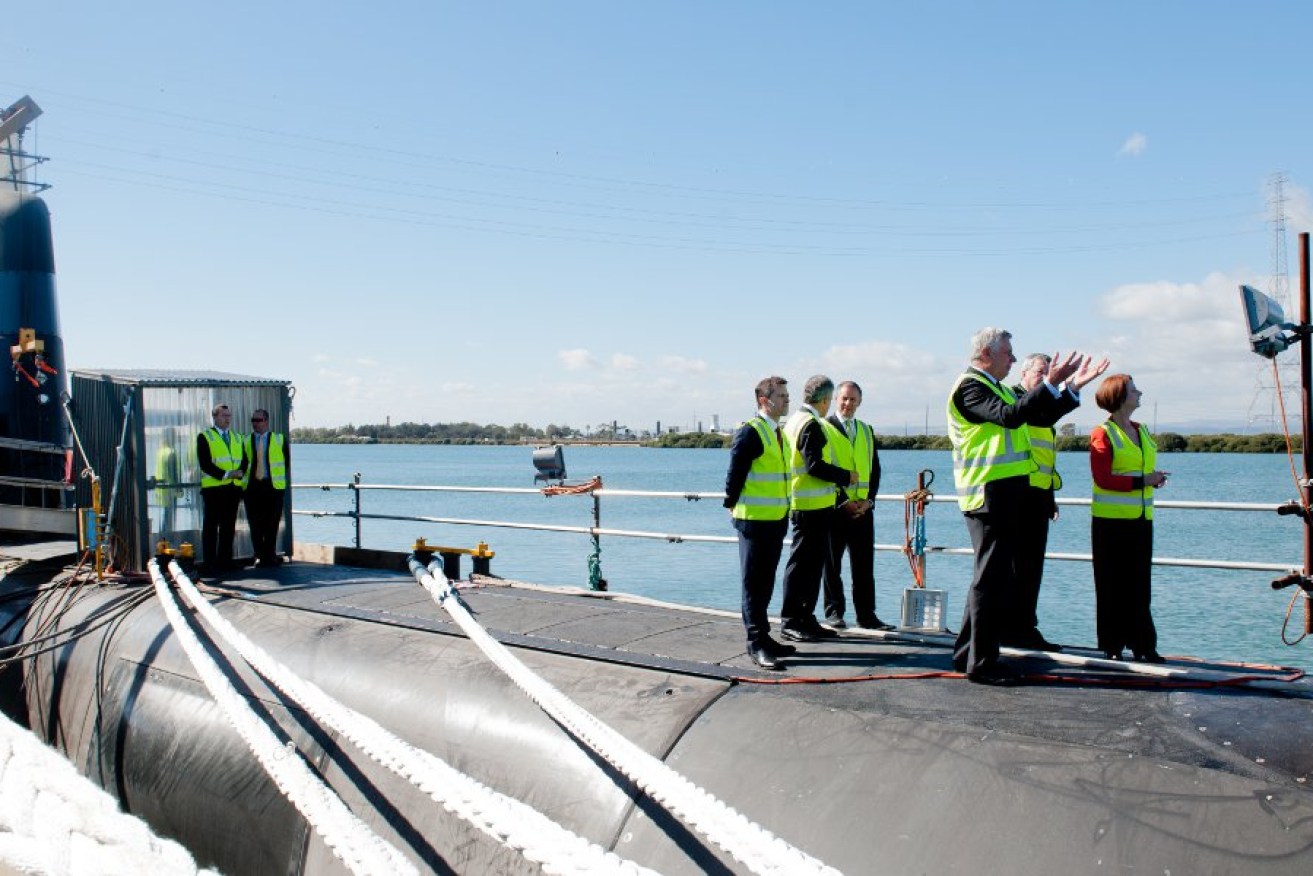Visualised: How Defence dominates govt tenders in SA

Then Prime Minister Julia Gillard, and State Premier Jay Weatherill inspect a Collins Class submarine at ASC in Osborne. Photo: Nat Rogers/InDaily
More than 70 per cent of all recorded Federal Government tender spending in South Australia between 2003 and 2012 has gone to military projects, an InDaily analysis reveals.
The data underscores the importance of Commonwealth military spending to the state’s economy – and the failure of other industry sectors to get in on the action.
SCROLL DOWN TO SEE THE DATA VISUALISATION
The biggest winners from the tender contracts awarded in the past decade are nearly all defence-related companies. The six biggest winners are Australian Aerospace (around $5.9bn), ASC (around $4.6bn), Coffey International Development (around $2.6bn, and the only non-defence focused company in the top six), BAE Systems (around $2.2bn) Surveillance Australia (around $1.3bn), and Saab Systems (around $850 million) .
In South Australia, the Department of Defence (around $8.1bn) and the Defence Material Organisation (around $9.4bn) dwarf all other departmental spends. There is daylight between defence and the next department – AusAid – with around $2.3bn in tenders offered between 2003 and 2012.
The data comes from the Federal Government’s tenders database, released as part of a federal open government initiative. InDaily has collated the data for the last decade.
Federal government agencies are required to put orders out to public tender when the amount is more than $10,000. Tenders represent agency spending – as distinct from program spending, which the Federal Government spends without going out to tender (to build a new rail line, for example). Also not included is the Federal Government’s GST grants to South Australia.
Unfortunately the tender data is riddled with misspellings and errors, making a 100 per cent accurate database very difficult to assemble.
InDaily has chosen to aggregate many of the listings which use slightly different names or spellings, in the interests of creating an as-accurate-as-possible database. Despite that, the data should only be treated as an approximate.
Defence vital to economy, says industry
“Twenty-five per cent of Australia’s defence industry is based in SA, employing 32 per cent of the nation’s defence industry workforce … not bad for a State with only 8 per cent of the nation’s population,” Defence Teaming Centre CEO Chris Burns told InDaily.
“The Defence industry in SA employs approximately 27,000 people in the State and generates approximately $1.8bn of revenue into the State each year.”
In a day dominated by defence commitments, Prime Minister Kevin Rudd said yesterday if elected he would ask the military’s top brass to start planning to move naval defence facilities in Sydney to Brisbane.
Opposition Leader Tony Abbott meanwhile this week pledged to raise defence spending to 2 per cent of GDP a year, up from a reported 1.59 per cent, by the end of the decade.
“If Rudd gets his way most of the ADF will be in Queensland which will draw defence industry and jobs away from the other States,” Burns said.
“Industry invested heavily on the back of an ambitious Defence White paper that Rudd delivered in 2009. Since then, our defence industry has suffered heavily from the $25bn the government has cut from the Defence budget over the last four years.
“If you want a viable industry base, there has to be a consistent flow of work. We shouldn’t talk about numbers of ships and submarines to be built. As a nation we should say we are going to build one ship per year and one submarine every two years. Simplistic, but effective.”
Who’s who of the big winners in SA
Australian Aerospace is a wholly-owned subsidiary of global helicopter manufacturer Eurocopter.
The company is employed to service, maintain and upgrade Australia’s airforce assets (including F/A-18s and P3 Orions).
Since 2003, the company’s SA operations have won tenders worth almost $8 billion. The company’s biggest contracts are the provision of 12 new troop transport helicopters, which the Defence Material Organisation currently notes as a Project of Concern.
“The key risks for this project over 2013-14 will be the timely resolution of the outstanding technical and supportability issues and the generation of the necessary flying rates to meet Navy and Army requirements,” the DMO says.
Surveillance Australia is a wholly owned subsidiary of UK-based Cobham Group. Cobham operates Australia’s coastal and maritime surveillance network, flying Dash 8 patrol aircraft to scout for, amongst other things, asylum seekers – a contract worth about $1.3 billion over the last decade.
Cobham generates about 48 per cent of their revenue from US defence contracts.
BAE Systems is the current local incarnation of the British Aircraft Corporation (originally BAC). The company’s largest contracts are for the provision of “marine transports” ($137 million), along with “war vehicles”, “launchers” and “satellites”. In SA the company manufactures components for the F-35 Joint Strike Fighter, ship-based missile-defence systems, and is upgrading the RAAF’s Wedgetail fleet with electronic countermeasures.
According to BAE, the company employs 1200 works in SA at Edinburgh, Holden Hill and Mawson Lakes.
Saab Group (who formerly owned the company producing SAAB automobiles) is a Swedish global defence giant. From their Mawson Lakes base, they supply a range of equipment to the defence forces.
Their most expensive tender is for the provision of unspecified “military watercraft”. Saab provide counter-improvised-explosives training for Australia’s Afghanistan forces, counter-rocket radar, missile countermeasures for Australia’s F/A-18 fleet, and combat systems and radars for the Navy’s amphibious assault ships.
They have offices in every region across the world. In Australia they employ about 360 people, mostly in Adelaide.
ASC, based at Osborne, has won more than $4.2 billion in contracts from the Federal Government since 2003. The local shipbuilder is currently maintaining Australia’s Collins-class submarine fleet. Its biggest current contract forms part of the $8 billion air warfare destroyer project, in conjunction with Raytheon Australia. ASC employs more than 3000 workers in South Australia and WA, and says it has a supply chain of more than 3000 companies.




